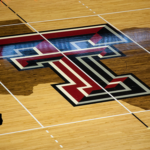Going back to that Athletic piece by CJ Moore($) (which I wrote about in June), one of the things that stuck with me was this quote about what type of offense we can expect from Texas Tech next year and why that offense is something wants to run.
Adams wants to play fast, learning from what’s hard for his defense to stop. He knows what you’re thinking. Every new coach says this to appease fans and recruits. But his desire seems to pass the BS sniff test. He convinced Barret Peery to leave his job as head coach at Portland State to help him, a sign that Adams is actually committed to the fast-pace cause. (Portland State finished in the top 40 in pace in two of Peery’s four seasons there.) Adams and his staff have also had video conferences with multiple NBA teams about space-and-pace philosophies, and he’s consulted Northwest Missouri State coach Ben McCollum, whose offense Adams says is game-changing in the way they screen and use angles. McCollum’s teams have won three of the last four Division II national titles.
“Our slogan is, ‘Together we attack,’” he says, “and so we do want to be aggressive on both ends of the floor and try to keep our opponent on their heels.”
It’s not hard to get the players to buy in to this style. No one wants to play slow. But Adams also has some credibility with his returners, who point out that Adams would occasionally draw up a quick-hitter and that they almost always worked. “He’s actually a genius on the offensive end, too,” super senior Marcus Santos-Silva says.
The why is important, something that I think that Mark Adams needs to immediately establish, which is that Adams wants to play both offense and defense with some tempo and although that’s probably going to be a bit of a misnomer in that Adams wants to play fast, but more importantly it is to play efficiently.
And that’s where this terrific piece by Stats By Will’s Will Warren where he breaks down the Northwest Missouri State offense, a team that went 38-0 in 2019, the first NCAA team to do so since 2008-09. You need to go read this article. If you love basketball, you need to go read that article. You’ll learn more reading that article than just about anything you do today (and I mean this, whether you are a doctor, mechanical engineer, garbage collector, whatever). Promise.
There’s a few terrific takeaways from this that I find fascinating, which is that McCollum believes in the ball screen, but does not believe in a set pattern for offense or set patterns for screens. There’s motion, but not your typical Knight-motion offense.
McCollum’s reasoning for his offensive success is two-fold: psychology and talent. “We find their individual strengths and get them to play towards those as often as we can get them to. (Allowing players to believe in themselves) is the main reason shots go in, in my opinion.” On the talent side: “Our guys that were setting the screens were very versatile. They could switch, post up, pick and pop for a shot. We set them so many different ways that it creates a lot of confusion for the defense.”
McCollum focuses on positivity and not negativity in terms of teaching, “I think when you speak from a positive tone, I think kids get a lot of confidence in what they should do. It naturally eliminates what they shouldn’t do. I’ve found that’s the best way to get kids to play without fear and with confidence.”
This past year Youssouf was on a basketball team and the coach on that team had wanted to coach Youssouf because he’s a pretty special athlete. The interesting thing to me in watching nearly every practice was that he taught the players how to attack the basket, which was something I had never considered, but the idea is that if a defender is on your hip, then you’ve got that guy beat and if you’re not taking the ball to the bucket, you’re doing it wrong, whether it be for a pass outside, or a shot at the rim. Yoyo excelled at this because he can get opposing players to turn their hips and when a player has turned their hips the way you want, there’s really no recovering. It was fascinating to watch 3rd and 4th graders learn this.
And you’ll see that, especially if you pay attention to the video clips, defenders turning their hips, then offensive players taking advantage of that, and then it’s church.
The other fascinating aspect was how McCullom described the idea that the way that his offense is run, which is essentially ball screens with no pattern, makes it incredibly difficult for defenders, but there’s nothing to “learning” the system other than to learn leverage and ball screens, which requires less time to focus on that on offense:
For four straight seasons (and then some), he becomes a seriously inspirational case for many. It’s worth remembering his reasoning for why he runs this offense in the first place: the ball screen, as a play type, may be the most difficult to defend. “You can do them so many different ways,” notes McCollum. Per McCollum, running a true motion offense with lots of cuts and down screens “requires a lot of practice work.” With ball screens: “you can be really good at them and work on them 25% of your practice.” Must be nice. I find it a little crazy that plays as good as these don’t require all that much practice time, but that’s basketball.
This article by Stats By Will was one of the more enjoyable things I’ve read in a long time and I’d tell you that if this is the offense that Adams brings to the table, with Adams’ high-end focus on defense, then I think you’ll see an absolute stunner of a team. Who would have thought that Adams would draw inspiration from Northwest Missouri State, but I sort of love it. Being innovative is fun as hell.








